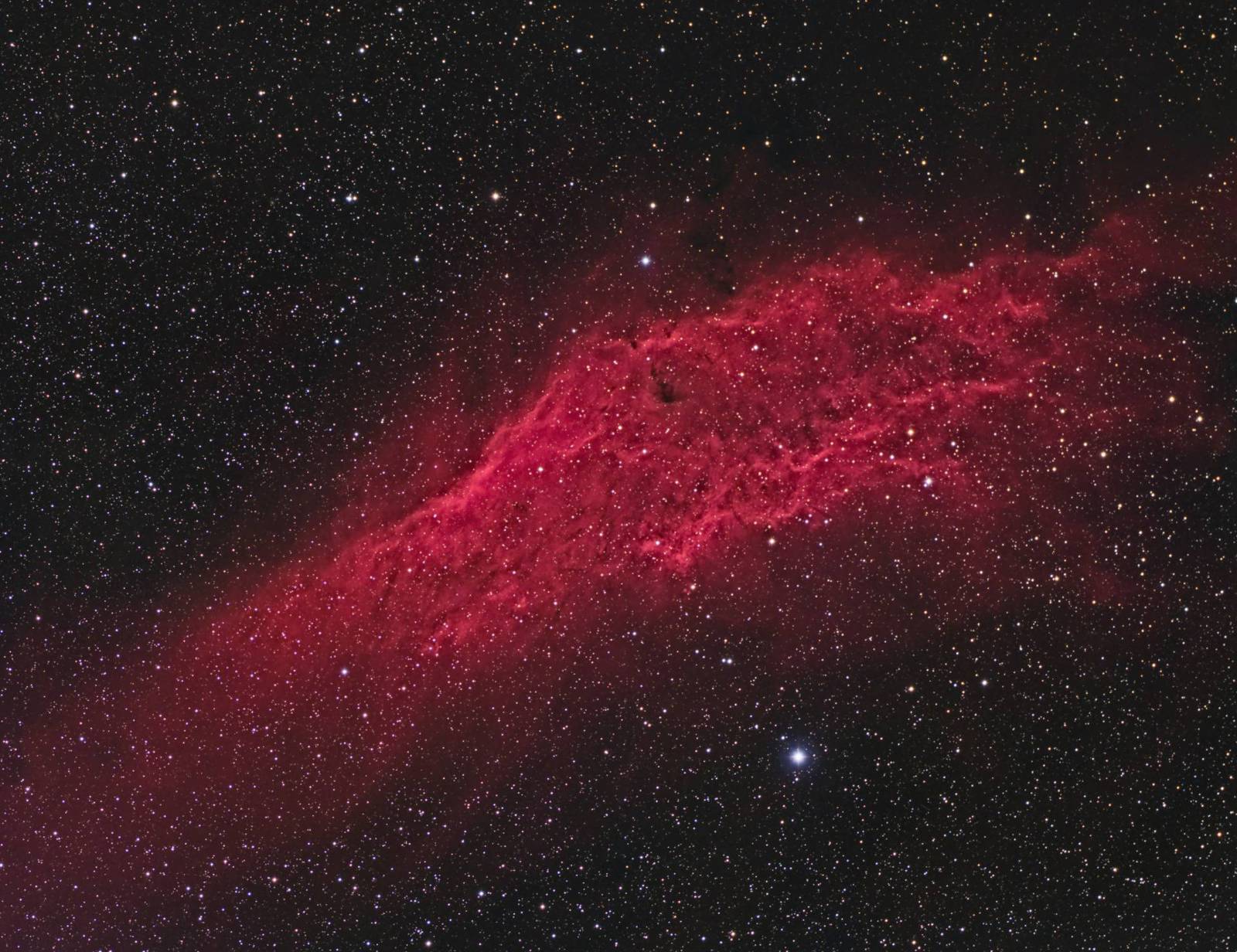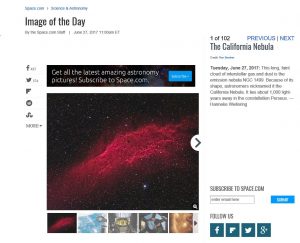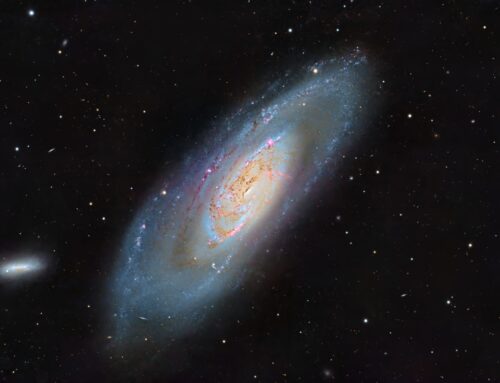NGC1499, The California Nebula
 Click image for full size version
Click image for full size version
December 26, 2016, Image of the Day at space.com June 27, 2017
 NGC1499 is known as the California Nebula because of its shape. It’s very difficult to see visually (I have tried and failed many times) but looks gorgeous in pictures. It lies about 1,000 light years from Earth in the constellation Perseus. The nebula is made mainly of hydrogen. This gas is glowing due to energy released from the brightest star in the image, a blue giant star called Menkib, or Xi Perseus. Menkib is 13,500 times as bright as the Sun in visible light and has a temperature around 37,000C, making it one of the intrinsically brightest and also the hottest star visible to the naked eye (note – if you include UV light it’s luminosity is 330,000 times the Sun’s). Menkib, like all massive stars, is living fast and will die young — maybe exploding in the next million years or so. In the upper left of this image, you can also find at least 6 small galaxies, some of which show some structure. Look for fuzzy “stars” or little needle-like objects.
NGC1499 is known as the California Nebula because of its shape. It’s very difficult to see visually (I have tried and failed many times) but looks gorgeous in pictures. It lies about 1,000 light years from Earth in the constellation Perseus. The nebula is made mainly of hydrogen. This gas is glowing due to energy released from the brightest star in the image, a blue giant star called Menkib, or Xi Perseus. Menkib is 13,500 times as bright as the Sun in visible light and has a temperature around 37,000C, making it one of the intrinsically brightest and also the hottest star visible to the naked eye (note – if you include UV light it’s luminosity is 330,000 times the Sun’s). Menkib, like all massive stars, is living fast and will die young — maybe exploding in the next million years or so. In the upper left of this image, you can also find at least 6 small galaxies, some of which show some structure. Look for fuzzy “stars” or little needle-like objects.
Tekkies:
Moravian G3-16200 EC camera (on loan from O’Telescope), Optolong Ha, R, G and B filters, 106mm Tak FSQ-106 at f/3.6, Paramount MX, QHY5 guide camera 50mm f.l. guide scope. Acquisition with the SkyX, Manually focused. All pre-processing and processing in PixInsight. Acquired from my SkyShed in Guelph. Gibbous moon for Ha, no moon for RGB, average transparency and poor seeing.
15x5m R, 10x5m G, 11x5m B and 6x15m Ha (total=4hr30m).
NB-RGB Creation
Creation and cleanup: Drizzle integration was used to make R, G, B and Ha masters, which were cropped and processed separately with DBE. R, G and B were combined to make an RGB image which was processed with BackgroundNeutralization. ColorCalibration was applied. The NBRGBCombination script was run with using Ha for red narrowband and a scale of 0.8. ColorCalibration was applied a second time.
Linear Noise Reduction: MultiscaleLinearTransform was used to reduce noise in the background areas of the NB-RGB file. Layer settings for threshold and strength: Layer 1: 3.0, 0.6 Layer 2: 2.0, 0.45 Layer 3: 1.5, 0.33 Layer 4: 1.0, 0.2 and Layer 5: 0.5, 0.13
Stretching: HistogramTransformation was applied to make a bright, pleasing image.
Synthetic Luminance:
Creation and cleanup of SynthL: The cleaned up Ha, R, G and B masters were combined using the ImageIntegration tool (average, additive with scaling, noise evaluation, iterative K-sigma / biweight midvariance, no pixel rejection).
Deconvolution: A star mask was made to use as a local deringing support. A copy of the image was stretched to use as a range mask. Deconvolution was applied (80 iterations, regularized Richardson-Lucy, external PSF made using DynamicPSF tool with about 20stars).
Linear Noise Reduction: MultiscaleLinearTransform was used to reduce noise in the background areas of the NB-RGB file. Layer settings for threshold and strength: Layer 1: 3.0, 0.6 Layer 2: 2.0, 0.45 Layer 3: 1.5, 0.33 Layer 4: 1.0, 0.2 and Layer 5: 0.5, 0.13.
Stretching: HistogramTransformation was applied using autostretch settings from ScreenTransferFunction.
Noise Reduction and Re-Stretch: TGVDenoise was applied in Lab mode with 300 iterations with a range mask used to protect high signal areas. This was followed by a HistogramTransformation to raise the black point (but with no clipping).
Combining SynthL with NB-RGB:
The processed SynthL was applied to the NB-RGB image using LRGBCombine.
Additional Processing
Dynamic Range Compression: HDRMultiscaleTransform was applied with default settings to compress the dynamic range in the brightest parts of the nebula.
Contrast Enhancement: The contrast was boosted in the same areas of the nebula with 2 passes of LocalHistogramEqualization (scale 52 and 165, strength 0.33, max contrast 1.5) using a mask to protect background and stars.
Final Steps: MultiscaleLinearTransform was used to sharpen the structures in the bright parts of the nebula (layers 2-4 at 0.05), followed by a pass of TGVDN on the L channel only, using default settings. Background, nebula and star brightness, contrast and saturation were adjusted in several iterations using Curves with masks as required. The mid-range blue was boosted slightly within the nebula. SCNR was applied to the background. The DarkStructureEnhance script was applied with a strength of 0.13.
Image scale is about 1.6 arcsec per pixel for this camera / telescope combination with Drizzle processing.






Leave A Comment